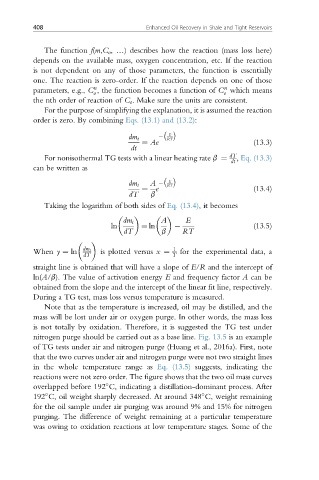Page 440 - Enhanced Oil Recovery in Shale and Tight Reservoirs
P. 440
408 Enhanced Oil Recovery in Shale and Tight Reservoirs
The function f(m,C o , .) describes how the reaction (mass loss here)
depends on the available mass, oxygen concentration, etc. If the reaction
is not dependent on any of those parameters, the function is essentially
one. The reaction is zero-order. If the reaction depends on one of those
n
n
parameters, e.g., C , the function becomes a function of C which means
o o
the nth order of reaction of C o . Make sure the units are consistent.
For the purpose of simplifying the explanation, it is assumed the reaction
order is zero. By combining Eqs. (13.1) and (13.2):
E
dm t RT
¼ Ae (13.3)
dt
dT
dt
For nonisothermal TG tests with a linear heating rate b ¼ , Eq. (13.3)
can be written as
E
dm t A RT
¼ e (13.4)
dT b
Taking the logarithm of both sides of Eq. (13.4), it becomes
dm t A E
ln ¼ ln (13.5)
dT b RT
When y ¼ ln dm t 1 for the experimental data, a
dT is plotted versus x ¼ T
straight line is obtained that will have a slope of E/R and the intercept of
ln(A/b). The value of activation energy E and frequency factor A can be
obtained from the slope and the intercept of the linear fit line, respectively.
During a TG test, mass loss versus temperature is measured.
Note that as the temperature is increased, oil may be distilled, and the
mass will be lost under air or oxygen purge. In other words, the mass loss
is not totally by oxidation. Therefore, it is suggested the TG test under
nitrogen purge should be carried out as a base line. Fig. 13.5 is an example
of TG tests under air and nitrogen purge (Huang et al., 2016a). First, note
that the two curves under air and nitrogen purge were not two straight lines
in the whole temperature range as Eq. (13.5) suggests, indicating the
reactions were not zero order. The figure shows that the two oil mass curves
overlapped before 192 C, indicating a distillation-dominant process. After
192 C, oil weight sharply decreased. At around 348 C, weight remaining
for the oil sample under air purging was around 9% and 15% for nitrogen
purging. The difference of weight remaining at a particular temperature
was owing to oxidation reactions at low temperature stages. Some of the

